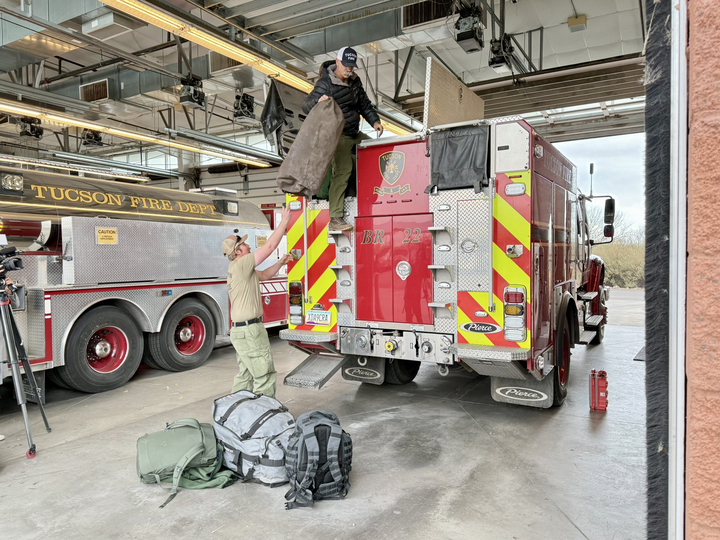Three UA students are committed to changing the lives of disabled persons by providing them with a social, well-mannered and friendly guide dog.
Chelsea Reaves, Morina Pierce and Max Gluck, all veterinary science juniors, each decided to spend a year raising and training a puppy to be used as a service dog to assist someone with a disability.
Gluck joined Paws for the Cause, a local offshoot of Guide Dogs for the Blind, after watching Reaves raise Roma, a female yellow Laborador. He soon afterward began raising Pecifica, a 9-month-old black female Labrador. Pierce has been raising Jenai, a 16-month-old female black Labrador, for almost a year now. Jenai is a survivor of canine parvovirus, a contagious viral disease, and she is now ready to go in for her last evaluation this Saturday with Roma.
To qualify as trainers, the students began by going to meetings for Paws for the Cause. Trainers first receive their dogs when they are about 8 weeks old. At this age, the puppies have no house manners. Puppies are not allowed out of the house until they have had all of their shots and can show decent behavior. At 17 weeks of age, the puppy gets a vest that allows them to go into public buildings.
Once the dog has its vest, it starts out with very short social outings. Roma’s first social outing was to a discussion class. After the first outing, trainers build up to a full day of classes, Reaves said.
“I first started her (Jenai) out by taking her into a gas station, and then I worked her up into going to class with me,” Pierce said.
Reaves and Pierce said the main responsibility is to train the dog in obedience and socialization. The dogs are taught to socialize with everything and not to react to the many stimuli around them. Throughout the training process, they are taught how to properly behave in elevators, walk on campus and not react to other dogs. It is important that each dog learns social behavior and obedience so that when they are guiding a blind person, the dog does not put the blind person in danger, Reaves said.
The dogs are taught general commands such as “sit down,” “stay,” “wait,” “go to sleep,” “go do your business” and “let’s go.” They are taught to sit in class for hours without creating any distractions. Through these training commands, the dogs learn to be very responsive.
“You can’t just expect to get a dog and walk with it everywhere. You have to train it to do everything, but it has become easier now,” Reaves said. “(Roma) is so well-trained that I don’t have to put as much effort into it.”
According to Pierce, the two most important things dogs must know are intelligent disobedience and re-command. Intelligent disobedience is when the dog is given a command that, if obeyed, would put the person being guided in danger, such as a forward command into traffic. A dog must know how to respectfully disobey commands like these. A re-command is the most emphasized command throughout the training period, and occurs when the owner calls out the dog’s name. The dog must go to its commander immediately.
“We try to keep it very positive reinforcement for the dogs,” Gluck said. “Patience is the key to raising a puppy.”
After spending such an extensive amount of time with their dogs, some students said they have grown very attached.
“The only thing I regret about this program is letting myself get too attached to Pecifica,” Gluck added. “It’s hard to let her go after you have been the one that raised and trained them.”
All dog trainers write monthly reports on their dog’s progress; they also describe the dog’s personality. The reports help the organization make the best possible match when assigning service dogs to owners.
“It is going to be hard, because I am very attached to her, but I know she is going to a great cause,” Pierce added. “I’ve seen working teams in action and blind people with dogs and it really makes a huge difference and not only in their mobility, but in the way they interact with other people, because now everyone wants to interact with them and their dog.”
According to Pierce, once dogs pass an evaluation after a year of training from their owners, they go through another three months of formal training. This is where they are taught techniques like how to cross the street with a blind person or how to notice a tree branch on the street that a blind person might not notice. They are taught to find a curbside and stop on it, avoid things that can be dangerous to the person but not to the dog, and how to respond to traffic. Once the dog passes these evaluations, it becomes a graduate guidance dog.
“I am happy for her and I know that she is going to do great things,” Reaves said. “She is absolutely the most wonderful dog I have ever had and I can only imagine how much she can benefit someone else, but I know I am going to be just sobbing about her leaving me this Saturday.”
Once the dog graduates, the rest of the work is up to the dog. A dog that shows any attachment to the trainer has its career changed. In the case of a career change, the dog returns to its trainer as a pet if the trainer still wants to adopt the dog, Gluck said.
“I absolutely love doing this, it’s just an enjoyment and it is a very rewarding hobby and experience,” Reaves added. “I would absolutely love to continue on raising puppies; maybe I’ll have my kids raise one in the future.”









